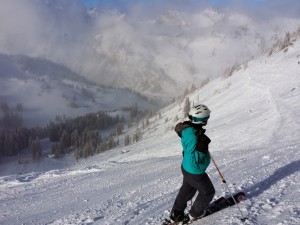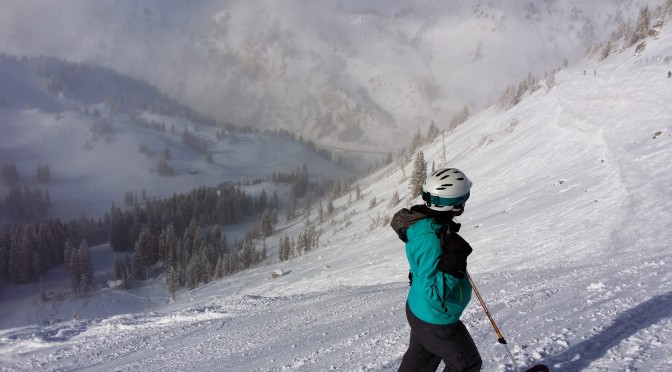Alta, UT – After hearing oral arguments on Tuesday, the 10th Circuit Court of Appeals in Denver is expected to take several months to decide whether or not a U.S. District Court Judge in Salt Lake City erred when he tossed out a lawsuit in September 2014. That lawsuit, filed by four snowboarders against Alta Ski Area and the U.S. Forest Service, seeks a permanent injunction to force Alta to allow snowboards on its lifts.
Couched in the Equal Protection Clause of the 14th Amendment, the Plaintiffs’ arguments seem frivolous at best, and a colossal waste of taxpayer resources at their worst (remember, the U.S. Forest Service is the U.S. Government, and the U.S. Government is you and me). The Equal Protection Clause is intended to protect classes of people from discrimination based on ethnicity, race, religion, sexual orientation…all things that make a person who they are, things that they can’t change. It wasn’t intended to protect people based on what kind of lumber they choose to strap to their feet. Snowboarders simply aren’t a protected class.
Equally laughable are the Plaintiffs’ claims that Alta excludes snowboarders because they’re perceived as unruly and inconsiderate, or wear baggy clothes. There are certainly jackasses who ski, too.
Now, in the interest of full disclosure, I’m an ardent fan of Alta. I spend upwards of 80 days per winter on its slopes, so in addition to my tax money paying for court time and to defend the Forest Service, the money I spend at Alta each winter is being used in part to defend the resort. I also have absolutely nothing against snowboarders, some of whom are among my closest friends, nor do I have any particular disdain for the sport of snowboarding. I’ve laughed heartily when I’ve watched snowboarders poach Alta’s runs from adjoining Snowbird in an Alta closing day tradition — it’s all in good fun, after all.
The distinction between two key terms inherent to this discussion — “snowboarders” and “snowboarding” — is absolutely critical. As Alta’s lawyers argued before the appeals court on Tuesday, the ski area doesn’t discriminate against snowboarders. In fact, it doesn’t discriminate against anyone. It simply has an equipment ban, a prohibition that as a private company it has a right to enact. Assuredly, snowboarders are always welcome at Alta — as long as they’re wearing skis.
“This case is about equipment, not people,” attorney Rick Thaler pleaded for Alta during Tuesday’s arguments. “It’s about a board, not the person using it.”
That fact, unfortunately, seems to be lost on the four Plaintiffs, who collectively call themselves Wasatch Equality.
Without a shred of credible evidence, Wasatch Equality contends that Alta excludes snowboarding because of a perceived management bias against or hatred of the sport, and that the Forest Service is complicit in that bias. They argue that because Alta operates on land leased from the Forest Service, it should be forced to open its slopes to all outdoor recreation, including snowboarding.
That lease agreement, however, temporarily makes the land Alta’s. As a private entity, Alta is entitled to enact business policies as it sees fit, and there’s no reason to doubt its claims that it has chosen to exclude snowboarding for safety and other business reasons, not the least of which is that some skiers are drawn to a skier-only mountain. That’s their right to do. It’s no different than a rancher who leases grazing land from the federal government telling me that I can’t camp on or ride my mountain bike across his pasture. Similarly, I’ll likely be spending the night in the Salt Lake County Grey Bar Motel if I try to ride a snowmobile up Brighton’s runs.
“What if I want to take my toboggan down the slope? Would that be an equal protection violation?” Judge Gregory Phillips insightfully asked Jonathan Schofield, an attorney for Wasatch Equality, during Tuesday’s hearing.
Let’s just say that I don’t plan on showing up in the lift line at Alta’s opening day this Friday with my snow saucer.
And what about Forest Service land that isn’t leased to a private corporation? It’s still public land — even more so, in fact — but the Forest Service prohibits any mechanized travel in areas federally designated as Wilderness Areas. Still, I don’t see any mountain bikers or hang gliders gathering together to demand equal protection under the 14th Amendment and calling themselves a protected class.
While I have no animus directed towards snowboarders or snowboarding, I’m nevertheless personally appreciative of the business decision that Alta has made, and judging by the financial success that Alta has achieved despite excluding a good chunk of the snow sports market, plenty of others must appreciate it, too. One judge at Tuesday’s hearing, in fact, asked Schofield about Alta customer surveys that overwhelmingly support the snowboard ban, which Schofield dismissed as a “pretext for taking a group of people and deciding they were undesirable and banning them for no reason.”
It’s undeniable that skiers and snowboarders follow different, and often conflicting traffic patterns, and have blind spots in different positions. Judge Harris L. Hartz asked Schofield on Tuesday if he could disprove a snowboarder’s blind spot; rather than address the question, Schofield instead responded with a straw man argument that snowboarding is statistically safer than skiing.
Snowboards also have a much greater surface area than a pair of skis, and thus have a significantly different impact upon the snow. Snowboards make bumps that have a different shape from those made with skis. With only skiers in the mix, Alta simply skis differently than any other ski area on the planet, a uniqueness to be lost forever should snowboarders ever load its lifts.

And then there are the traverses. Snowboarders who want access to Alta should be careful what they wish for, as its layout is markedly different from that of most ski areas. Instead of lifts that reach a mountain peak with runs fanning out in all directions, most of Alta’s lifts simply access a high point upon a ridge line. From there, skiers follow long traverses — some of which are a mile long — to reach the run they want to ski, and only then do they drop into the fall line. Some of those traverses follow gradual downhill paths, but others are quite flat, and some even gradually ascend.
Should snowboarders ever gain access to Alta, most of those traverses will prove to be all but impossible to negotiate on a snowboard, which by its very design eliminates independent foot action. That would force a snowboarder to unstrap and walk. Far worse than the post holes those footsteps would leave in the traverse, in many locations that places the snowboarder at a substantial risk of falling hundreds of feet down the hard, steep slope that the traverse crosses. That’s a valid safety concern. There are, in fact, many traverses at Alta where signs explicitly prohibit skiers from removing their skis, for that very reason. Personally, I’d never dream of crossing some of those places without metal edges.
If a snowboarder (or admittedly a skier) chooses to instead follow gravity and set a line below the existing traverse, the slope is now cut by a myriad of traverse lines, ruining the downhill experience for those who wish to ski that slope. That’s why there are signs on some Alta traverses that prohibit that, too.
Backers of Wasatch Equality’s strategy are letting their emotional involvement in the issue override rational thought. There are literally hundreds of ski areas in the U.S., and only three of them don’t allow snowboarding. Neither of the other two operate on Forest Service land, and it’s very illustrative that Wasatch Equality had to construe the Equal Protection Clause in such a contorted way to try to gain access to Alta’s slopes.
On Tuesday, Judge Hartz asked Wasatch Equality whether or not its claims could pass a rational basis test.
Simply stated, they can’t.
——
Author Marc Guido is the managing editor of First Tracks!! Online Ski Magazine. The opinions expressed here are his own, and do not necessarily reflect those of First Tracks!! Online.


Very well said, Mark! This whole lawsuit has been ridiculous and I feel so bad for alta having to waste their money on this process. Maybe wasatch equality would have a better shot if they argued they were handicapped and went after the protections for the disabled instead.
Skiplaylive.com